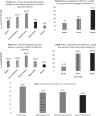Effect of COVID-19 on Household Food Insecurity and Poverty: Evidence from Ghana
- PMID: 34456451
- PMCID: PMC8385484
- DOI: 10.1007/s11205-021-02766-9
Effect of COVID-19 on Household Food Insecurity and Poverty: Evidence from Ghana
Abstract
Following the outbreak of COVID-19 and its heavy toll on the global community and humanity, a fierce debate on the pandemic and Sustainable Development Goals (SDGs) performance nexus has emerged. While the literature on this subject remains highly contested, evidence within the Ghanaian contest is sparse. Thus, we present micro-level evidence on how COVID-19 poses a threat to hunger and poverty as SDGs in Ghana. Precisely, we examined the effect of COVID-19 on households' food insecurity and poverty and further analysed gender and locational sub-samples for differential effects. Data on 3905 households were obtained via concurrent online survey and telephone interviews. The results indicate that, on several occasions, a significant number of the sampled households (57.76%) did not get enough food to eat due to the pandemic. The proportion of households that went on several times without clean water for home use and access medicines/medical treatments were 50.52% and 52.22%, respectively. About 60.72% of the sampled households affirmed that, on several times, they did not have enough income due to the pandemic. At the same time, the share of households that suffered food insecurity due to the pandemic was 69.04%. Instrumenting for COVID-19 using distance to the affected communities, we find that a standard deviation increase in COVID-19 is associated with a rise of 0.232 and 0.289 standard deviations in poverty and food insecurity, respectively. Our results are robust to alternative estimation approaches to addressing the endogeneity of COVID-19 and other sensitivity checks. We conclude that Ghana would need to develop a new spectrum of gender- and location-sensitive policies that engender social inclusion as a conduit to expediate the attainment of zero poverty and hunger.
Supplementary information: The online version contains supplementary material available at 10.1007/s11205-021-02766-9.
Keywords: COVID-19; Food insecurity; Ghana; Pandemic; Poverty.
© The Author(s), under exclusive licence to Springer Nature B.V. 2021.
Conflict of interest statement
Conflict of InterestThere are no conflict of interest.
Figures
References
-
- Alon, T. M., Doepke, M., Olmstead-Rumsey, J., & Tertilt, M. (2020). The impact of COVID-19 on gender equality. National Bureau of Economic Research.
-
- Amoah-Nuamah J, Musah-Abdul W, Sampson LE. COVID-19 pandemic partial lockdown in Ghana and it s implications on livelihoods of informal workers in affected communities. Journal of Economics and Sustainable Development. 2020;11(8):35–40.
LinkOut - more resources
Full Text Sources


